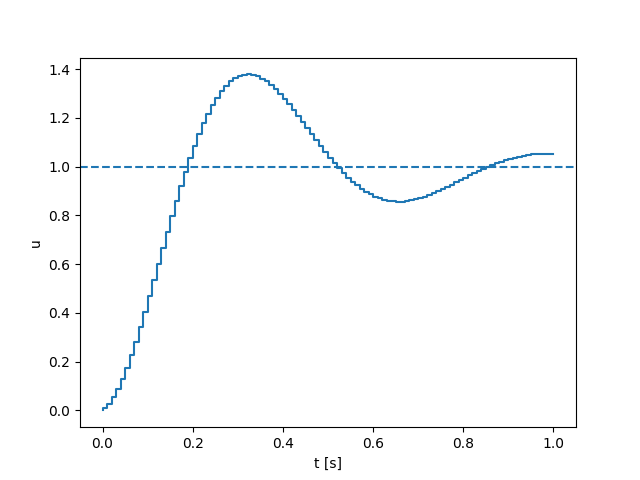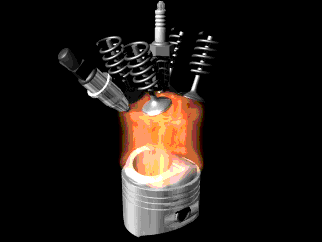Contact-rich Planning for Robotic Manipulation with Quasi-static Contact Models
Tao Pang
Word cloud of my PhD thesis :D

Why contact-rich manipulation?

Collision-free Motion Planning
Interact with the world


Smaller

Why is contact-rich planning hard?
Contact dynamics is non-smooth!
\(\mathrm{u}\): un-actuated
control input: commanded ball position
\(\mathrm{a}\): actuated
What does the plot of this dynamics look like? (demo)
Contact dynamics is non-smooth
Moving the box to the right
No contact
Contact
Solve with gradient descent
No contact
Contact
Smoothing comes to the rescue!
Smoothing comes to the rescue!
No contact
Contact

Solve with gradient descent
No contact
Contact

Moving the box to the left?
No contact
Contact
Solve with gradient descent
No contact
Contact


Stuck in local minima!
Global Search with Contact Modes
System
Number of modes
- Left not touching
- Left touching
- Right touching
- Right not touching
x
Friction cone
- Not touching
- Sticking
- Sliding left
- Sliding right
y
Number of faces
x
x
y
z

- Not touching
- Sticking
- 4 directions of sliding
Number of contact pairs.
Model-based Planning through Contact: a Quick Review
- Trajectory Optimization through Contact
- Mordatch, Igor, Emanuel Todorov, and Zoran Popović. "Discovery of complex behaviors through contact-invariant optimization." ACM Transactions on Graphics (TOG), 2012.
- Hogan, François Robert, and Alberto Rodriguez. "Feedback control of the pusher-slider system: A story of hybrid and underactuated contact dynamics." arXiv preprint arXiv:1611.08268, 2016.
- Posa, Michael, Cecilia Cantu, and Russ Tedrake. "A direct method for trajectory optimization of rigid bodies through contact." The International Journal of Robotics Research, 2014.
- Aydinoglu, Alp, and Michael Posa. "Real-time multi-contact model predictive control via admm." 2022 International Conference on Robotics and Automation (ICRA), 2022.
- Cheng, Xianyi, et al. "Contact mode guided motion planning for quasidynamic dexterous manipulation in 3d." 2022 International Conference on Robotics and Automation (ICRA), 2022.
- Marcucci, Tobia, et al. "Approximate hybrid model predictive control for multi-contact push recovery in complex environments." 2017 IEEE-RAS 17th International Conference on Humanoid Robotics (Humanoids), 2017.
-
Tao Pang*, H.J. Terry Suh*, Lujie Yang, Russ Tedrake, "Global Planning for Contact-Rich Manipulation via Local Smoothing of Quasi-dynamic Contact Models", under review, 2022.
- Locally enumerate mode switches (fast)
- Globally enumerate Mode Switches (slow)
Good Scalability (Smoothed dynamics)
Limited Scalability (Mode Transitions)
Local Planning
Global Planning
- Our method: Global planning with RRT + Smoothed dynamics [7]

[1] Mordatch et al.

[3] Posa et al.

[6] Marcucci et al.

[4] Aydinoglu and Posa.

[2] Hogan and Rodriguez.
- Sampling mode switches.
[5] Cheng et al.

What can we learn from RL (reinforcement learning)?

- RL generates impressive policies for specific tasks, but...
- RL requires heavy offline computation,
- The Nvidia policy is trained with "only 8 NVIDIA A40 GPUs" for 60 hours.
- The learned policy does not generalize (e.g. to opening a door).
- RL requires heavy offline computation,
- (OpenAI) Andrychowicz et al. "Learning dexterous in-hand manipulation." The International Journal of Robotics Research, 2020.
- (Nvidia) Handa et al. "DeXtreme: Transfer of Agile In-hand Manipulation from Simulation to Reality", arXiv preprint, 2022.
-
H.J. Terry Suh*, Tao Pang*, Russ Tedrake, “Bundled Gradients through Contact via Randomized Smoothing”, RA-L, 2022.
-
Tao Pang*, H.J. Terry Suh*, Lujie Yang, Russ Tedrake, "Global Planning for Contact-Rich Manipulation via Local Smoothing of Quasi-dynamic Contact Models", under review, 2022.
[1] OpenAI, 2018
[2] Nvidia, 2022

How does RL power through non-smooth contact dynamics? [3][4]
- RL maximizes a stochastic reward using gradients estimated from sampling.
- Sampling has a smoothing effect on the gradients.
In model-based planning, we can smooth contact dynamics, but without using samples (faster!).
Terry Suh

What our planner can do
What our planner can do
Contributions
- A novel contact dynamics model which is
- quasi-static
- convex
- differentiable
- amenable to smoothing
- A sampling-based global search algorithm guided by the proposed contact model.

A contact-rich planner that can generate plans for complex systems involving dexterous hands / hardware with about 1 minute of online computation on a laptop.
In contrast, RL-based methods needs tens of hours of offline computation on a beefy workstation.
Our planner is enabled by
A Quasi-static, Convex, Differentiable Contact Dynamics Model
What is quasi-static dynamics?
- Quasi-static: velocity is small so that inertial and Coriolis forces are negligible.
- \(q \coloneqq [q^\mathrm{u}, q^\mathrm{a}]\): system configuration.
- \(q^\mathrm{a}\): actuated, imepdance-controlled robots
- \(q^\mathrm{u}\): un-actuated objects.
- \( u \): position command to the stiffness-controlled robots [1].
- \(\delta q \coloneqq q_+ - q\)
- \(h\): step size in seconds.
\( q_{+} = f(q, u)\)
- \(\lambda_i\): contact forces/impulses
- \(\phi_i \): signed distances
(KKT)
- A convex quadratic program (QP), after linearizing \(\phi_i\).
- "Minimizing potential energy, subject to non-penetration constraints."
-
Tao Pang, Russ Tedrake, "A Convex Quasistatic Time-stepping Scheme for Rigid Multibody Systems with Contact and Friction", ICRA, 2021.
Force balance of the robot.
Force balance of the object.
Non-penetration.
"Contact forces cannot pull."
"Contact force needs contact."
Quasi-static dynamics is good for manipulation planning!
- Spatial benefit: Smaller state space (\([q, v]\) vs. only \(q\)).
-
Temporal benefit: Ignoring transients => looking into the future with fewer steps.
-
Many manipulation tasks are quasi-static.


Second-order Dynamics
Quasi-static Dynamics
Quasi-static dynamics needs regularization
Quasi-static Dynamics
- The quadratic cost is positive semi-definite.
- The object can be anywhere between the robot and the wall.
Regularized least squares
Regularized Quasi-static Dynamics
- The quadratic cost is now positive definite.
- "Among all possible object motions, give me the one that moves the least."
- Picking \(\epsilon = m^\mathrm{u} / h\) gives Matt Mason's definition of quasi-dynamic dynamics.
What about general systems with friction?
- For a frictionless multi-body system with \(n_\mathrm{c}\) contacts, the dynamics can be solved as a QP:
- \(\mathcal{K}^\star_i\) is the dual of the \(i\)-th friction cone.
- Still convex!
- Anitescu [1] has a nice convex approximation of Coulomb friction constraints, allowing us to write down the dynamics as a Second-Order Cone Program (SOCP):
Tangential displacements
Dynamics of the Toy Problem
- Anitescu, Mihai. "Optimization-based simulation of nonsmooth rigid multibody dynamics." Mathematical Programming 105.1 (2006): 113-143.
Differentiability
Convex, Quasi-Static, Differentiable Dynamics (an SOCP)
- \(\mathbf{A}, \mathbf{B}\) can then be computed by applying the Implicit Function Theorem to the active constraints at optimality.
- Standard practice for many differentiable simulators.
- Allows first-order randomized smoothing.



Analytic Smoothing
Optimality Condition
KKT
Original Dynamics
Smoothed Dynamics
Analytic Smoothing with Friction
Put constraints in a generalized log for \(\mathcal{\kappa}_i^\star\)
- An unconstrained convex program.
- Can be solved with Newton's method.
- Also differentiable.
Convex, Quasi-Dynamic, Differentiable Dynamics (an SOCP)
Notation:
Original dynamics
Smoothed dynamics
Global Sampling-based Contact-rich Planning with Quasi-static Contact Models
Smoothed gradients enable trajectory optimization for dexterous hands, but...
Task: Turning the ball by 30 degrees.
What about 180 degrees?
Finding this trajectory requires powering through local minima!
Sampling-based Motion Planing is Great at Global Exploration
- Rapidly-Exploring Random Tree (RRT): iteratively builds a tree that fills the state space. [1]
- Steven M. LaValle, "Planning Algorithms", Cambridge University Press , 2006.
One iteration of RRT (simplified)
(1) Sample subgoal
(2) Find nearest node
(3) Grow towards
"Nearest" is tricky to define under dynamics constraint.
- Dynamic reachability is essential for efficient exploration. [1]


- H.J.T. Suh, J. Deacon, Q. Wang, "A Fast PRM Planner for Car-like Vehicles", self-hosted, 2018.
How do we measure reachability under the contact-dynamics constraint?
A distance "metric" based on smoothed linearization
Smoothed Contact Dynamics
A node in the RRT tree: \(\bar{q} = [\bar{q}^\mathrm{a}, \bar{q}^\mathrm{u}]\)
Take the rows corresponding to the object:
Smoothed
Smoothed Input Linearization:
\(\varepsilon \) sub-level set
configuration space of the object.
un-actauted(objects)
\(d_\rho^\mathrm{u}(\cdot; \bar{q})\) locally reflects dynamic reachability


\(\varepsilon \) sub-level set
(Distance Metric Demo)
RRT through contact (so far)
One iteration of RRT through Contact
(1) Sample subgoal \(\blacktriangle\)
(2) Find nearest node
\(q^\mathrm{a}\) is only changed locally, this is against the RRT spirit! (demo)
Dynamically-consistent Extension
is only valid locally.
(3) Grow towards \(\blacktriangle\)
Introducing contact sampling
One iteration of RRT through contact, with contact sampling
(1) Sample a different grasp (\(q^\mathrm{a}\)) for one of the nodes, giving a new distance metric
Contact sampling allows global exploration of \(q^\mathrm{a}\) on the contact manifold!
(2) Find nearest node
(3) Grow towards
Contact-sampler is system-specific

- Treat each finger as a robot arm and solve IK.

- With the hand open, pick a random direction to close the fingers until contact.
RRT through contact
Three modifications to the vanilla RRT are made:
- Nearest node on tree is found using \( d^\mathrm{u}_{\rho}(q; \bar{q}) \).
- Contact sampling: global exploration of robot configuration near the contact manifold.
- Dynamic-consistent extension: edges respect non-smooth quasi-static dynamics.
Distance Metric
RRT tree for a simple system with contacts


Ablation study: what trees look like after growing a fixed number of nodes.
Sim2Real/Hardware Transfer
Sim2Real/Hardware Transfer
Sim2Real/Hardware Transfer
What's next?
Low-resolution models
High-resolution models


Locomotion
[Boston Dynamics]


Heat Cycle of an Internal Combustion Engine
Contact-rich Manipulation
Quasi-static contact dynamics?
- Full second-order dynamics?
- Second-order centroidal dynamics?
End of Presentation
Quasi-static dynamics is good for manipulation planning!
- Spatial benefit: Smaller state space (\([q, v]\) vs. only \(q\)).
-
Temporal benefit: Ignoring transients => looking into the future with fewer steps.
-
Many manipulation tasks are quasi-static.


Second-order Dynamics
Quasi-static Dynamics
RRT through contact (so far)
One iteration of RRT through Contact
(3) Grow towards
But only take small actions.
Normalized ellipsoid volume

(1) Sample subgoal
(2) Find nearest node
\(q^\mathrm{a}\) is only changed locally!
Introducing contact sampling
One iteration of RRT through contact, with contact sampling
(1) Sample a different grasp (\(q^\mathrm{a}\)) for one of the nodes, giving a new distance metric
Contact sampling allows global exploration of \(q^\mathrm{a}\) on the contact manifold.

Normalized ellipsoid volume
(2) Find nearest node
(3) Grow towards
But only take small actions.
Sim2Real/Hardware Transfer

Rotating the Ball by 45 degrees.
The modified RRT works well for contact-rich tasks!


Planning wall-clock time (seconds)
Why is contact-rich planning hard?
Contact dynamics is non-smooth!
(a)
(b)
No contact
Contact

No contact
Contact

Global Search with Contact Modes
No contact
Contact
Solve with gradient descent
No contact
Contact
(a)
(b)
No contact
Contact
No contact
Contact
(c)
(d)


Why is contact-rich planning hard?
Contact dynamics is non-smooth!
Two solutions
Descend with gradients of smoothed dynamics
Reason explicitly about contact mode transitions
Contact
No Contact
- Non-linear optimization can scale to complex systems.
- But descent methods get stuck in local minima.
- Good at escaping local minima,
- But mode enumeration scales poorly (exponentially) with the number of contacts.
No contact
Contact

Push Left
Do not Push Left
Push Right
Do not Push Right
x
phd_defense_deck
By Pang
phd_defense_deck
- 448



